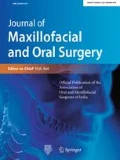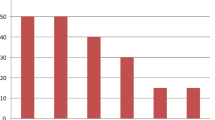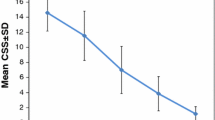Abstract
Objective
To correlate the clinical course and biochemical analysis in odontogenic space infections.
Methods
A randomized prospective study was undertaken in 50 patients presenting with infections of odontogenic origin. The data were subjected to statistical analysis to co-relate the values of CRP, WBC count and ESR with the clinical course of odontogenic infections. The statistical analysis was carried out using SPSS Version 17.0 clinical parameters included pain, swelling, mouth opening, dyspnea, dysphagia, hoarseness, body temperature, active discharge, length of hospital stay and number of fascial spaces involved.
Results
There was a significant correlation between all the clinical parameters and biochemical markers preoperatively as well as on various postoperative days.
Conclusion
According to the percentage rate of fall, CRP was considered as the best indicator of clinical course/recovery of the patient, followed by WBC count and ESR, respectively.





Similar content being viewed by others
References
Ylijoki S, Hanelle JS, Suvronen R, Meurman JH, Lindquist C (2001) Differences between patients with or without the need for intensive care due to severe odontogenic infections. J Oral Maxillofac Surg 59:867–872
Ren TF, Malmstrom HS (2007) Rapid quantitative determination of C-reactive protein at chair side in dental emergency patients. Oral Surg Oral Med Oral Pathol Oral Radiol Endodontol 104:49–55
Ayazi P, Mahyar A, Daneshi M, Hashemi HJ, Pirouzi M, Esmailzadehha N (2013) Diagnostic accuracy of the quantitative C-reactive protein, erythrocyte sedimentation rate and white blood cell count in urinary tract infections among infants and children. Malays J Med Sci 20:40–46
Srivanitchapoom C, Sittitrai P, Pattarasakulchai T (2012) Tananuvat R. Deep neck infection in Northern Thailand. Eur Arch Otorhinolaryngol 269(1):241–246
Volanakis JE (2001) Human C-reactive protein: expression, structure, and function. Mol Immunol 38:189–197
Shetty JN, Shah PD (2013) A comparative biochemical evaluation of serum C-reactive protein and erythrocyte sedimentation rate in healthy individuals and patients having odontogenic infections. Int J Sci Res 2:460–461
Sharma A, Gokkulakrishnan S, Shahi AK, Kumar V (2012) Efficacy of serum CRP levels as monitoring tools for patients with fascial space infections of odontogenic origin: a clinicobiochemical study. Natl J Maxillofac Surg 3:148–151
Sharma A, Giraddi G, Shahi AK (2014) Efficacy of serum prealbumin and CRP levels as monitoring tools for patients with fascial space infections of odontogenic origin: a clinicobiochemical study. J Maxillofac Oral Surg 13(1):1–9
Choi MK, Kim SB, Kim KD, Ament JD (2014) Sequential changes of plasma CRP, ESR and WBC count in spine surgery: a comparison between lumbar open discotomy and posterior lumbar interbody fusion. J Korean Neurosurg Soc 56:218–223
Singh WT, Singh WR, Devi WM, Devi NA (2012) C-reactive protein as a monitoring tool for fascial space infections of odontogenic origin: a prospective study. IJCD 3(3):18–22
Pepsy MB, Hirschfield GM (2003) C-Reactive Protein: a critical update. J Clin Invest 111(12):1805–1812
Hirschfield GM, Gallimore JR, Kahan MC, Hutchinson WL, Sabin CA, Benson GM, Dhillon AP, Tennent GA, Pepsy MB (2004) C-reactive protein and cardiovascular disease: new insights from an old molecule. QJM 97(3):163–166
Pinilla JC, Hayes P, Laverty W, Arnold C, Laxdal V (1998) C-reactive protein to prealbumin ratio correlates with the severity of multiple organ dysfunction. Surgery 124(4):799–805
Seppanen L, Lauhio A, Lindquist C, Suuronen R, Rautema R (2008) Analysis of systemic and local odontogenic infection complications requiring hospital care. J Infect 57(2):116–122. https://doi.org/10.1016/j.jinf.2008.06.002 (Epub 2008 Jul 22)
Lemberg KK, Seppanen L, Lauhio A, Lindquist C, Rautema R (2011) Is dental treatment of an infected tooth a risk factor for locally invasive spread of infection? J Oral Maxillofac Surg 69(4):986–993. https://doi.org/10.1016/j.joms.2010.05.015 (Epub 2010 Oct 14)
Stathopoulos P, Igoumenakis D, Shuttleworth J, Smith W, Ameerally P (2017) Predictive factors of hospital stay in patients with odontogenic maxillofacial infections: the role of C-reactive protein. Br J Oral Maxillofac Surg 55(4):367–370
Cunningham RC, Knight AK (2006) Inflammation and autoimmune complications of common variable immune deficiency. Autoimmun Rev 5(2):156–159 (Epub 2005 Nov 2)
Chana RS, Khalid M, Redhu N, Nazir B, Khalid S, Jha A (2012) Diagnostic value of ultrasonography in evaluation and management of acute abdominal condition in paediatric age group. Afr J Paediatric Surg 9(3):198–201. https://doi.org/10.4104/0189-6725.104719
Bali R, Sharma P, Gaba S (2015) Use of metronidazole as part of an empirical antibiotic regimen after incision and drainage of infections of the odontogenic spaces. Br J Oral Maxillofac Surg 53:18–22
Bagul R, Chandan S, Sane VD, Patil S, Yadav D (2016) Comparative evaluation of C-reactive protein and WBC count in fascial space infections of odontogenic origin. J Maxillofac Oral Surg. https://doi.org/10.1007/s12663-016-0953-z
Acknowledgements
The authors would like to thank late Dr. Sumeet Sandhu for her guidance and support in conducting the present study.
Author information
Authors and Affiliations
Corresponding author
Ethics declarations
Conflict of interest
The authors declare that they have no conflict of interest.
Ethical Approval for Research Involving Human Participants
All procedures performed in the study involving human participants were in accordance with the ethical standards of the institutional research committee and with the 1964 Helsinki declaration and its later amendments or comparable ethical standards.
Informed Consent
Informed consent was obtained from all the individual participants included in the study.
Rights and permissions
About this article
Cite this article
Kaur, A., Sandhu, A., Kaur, T. et al. Correlation Between Clinical Course and Biochemical Analysis in Odontogenic Space Infections. J. Maxillofac. Oral Surg. 18, 203–209 (2019). https://doi.org/10.1007/s12663-018-1132-1
Received:
Accepted:
Published:
Issue Date:
DOI: https://doi.org/10.1007/s12663-018-1132-1




